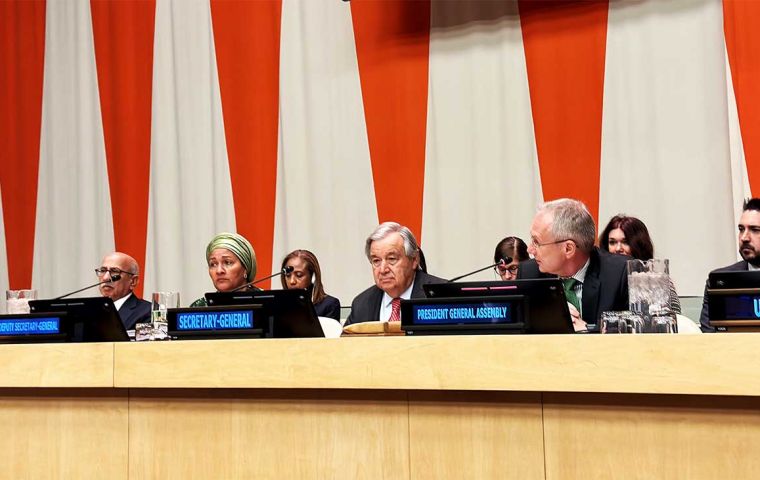MercoPress. South Atlantic News Agency
WMO Bulletin shows 2024 recovery of ozone layer, on 40th anniversary of UN Vienna Convention
 “Forty years ago, nations came together to take the first step in protecting the ozone layer, guided by science, united in action,” UN Secretary-General António Guterres.
“Forty years ago, nations came together to take the first step in protecting the ozone layer, guided by science, united in action,” UN Secretary-General António Guterres.  “The Vienna Convention and its Montreal Protocol became a landmark of multilateral success. Today, the ozone layer is healing”.
“The Vienna Convention and its Montreal Protocol became a landmark of multilateral success. Today, the ozone layer is healing”. The World Meteorological Organization Bulletin, WMO, reported that the low level of ozone depletion observed in 2024 was partly due to naturally occurring atmospheric factors, which drive year-to-year fluctuations. However, the long-term positive trend reflects the success of concerted international action.
The WMO Ozone Bulletin was issued for World Ozone Day on 16 September and the 40th anniversary of the Vienna Convention, which recognized stratospheric ozone depletion as a global problem and provided the framework for mobilizing international cooperation in ozone research, systematic observations and scientific assessments.
“Forty years ago, nations came together to take the first step in protecting the ozone layer — guided by science, united in action,” said United Nations Secretary-General António Guterres.
“The Vienna Convention and its Montreal Protocol became a landmark of multilateral success. Today, the ozone layer is healing. This achievement reminds us that when nations heed the warnings of science, progress is possible,” he said.
To date, the Montreal Protocol has led to the phase-out of over 99% of the production and consumption of controlled ozone-depleting substances, which were used in refrigeration, air conditioning, firefighting foam and even hairspray. As a result, the ozone layer is now on track to recover to 1980s levels by the middle of this century, significantly reducing risks of skin cancer, cataracts, and ecosystem damage due to excessive UV exposure.
“The theme for World Ozone Day is From Science to Global Action. It mirrors WMO’s 75th anniversary slogan Science for Action. This is no coincidence,” said WMO Secretary-General Celeste Saulo.
“WMO’s scientific research into the ozone layer dates back decades. It is underpinned by trust, international collaboration and commitment to free data exchange – all cornerstones of the world’s most successful environmental agreement,” she said.
Protecting the ozone layer and thereby human, environmental and agricultural health has enabled significant progress towards achieving many of the United Nations Sustainable Development Goals, including SDG 3 (Good Health and Well-Being), SDG 13 (Climate Action), SDG 2 (Zero Hunger) and SDG 15 (Life on Land), he said.
Compared to previous years, total stratospheric ozone cover was higher over much of the globe, according to the WMO Bulletin.
The depth of 2024 Antarctic ozone hole – which appears over the Antarctic every spring - was below the 1990–2020 average, with a maximum ozone mass deficit (OMD) of 46.1 million tons on 29 September. It was smaller than the relatively large holes between 2020 and 2023.
The UN Environment Program and WMO co-sponsor a quadrennial Scientific Assessment of Ozone Depletion, which assembles and assesses the best available scientific knowledge.
If current policies remain in place, the ozone layer is expected to recover to 1980 values (before the appearance of the ozone hole) by around 2066 over the Antarctic, by 2045 over the Arctic and by 2040 for the rest of the world
The World Meteorological Organization (WMO) is a specialized agency of the United Nations responsible for promoting international cooperation in atmospheric science and meteorology. WMO monitors weather, climate, and water resources and provides support to its Members in forecasting and disaster mitigation. The organization is committed to advancing scientific knowledge and improving public safety and well-being through its work.




Top Comments
Disclaimer & comment rulesCommenting for this story is now closed.
If you have a Facebook account, become a fan and comment on our Facebook Page!